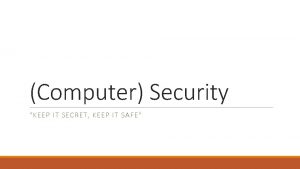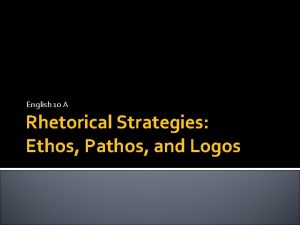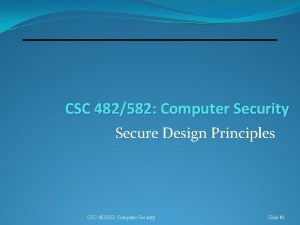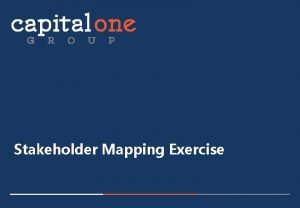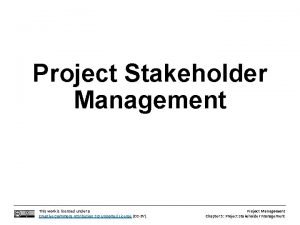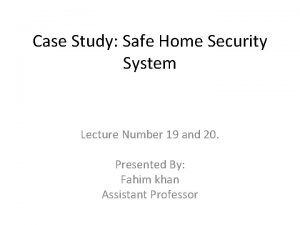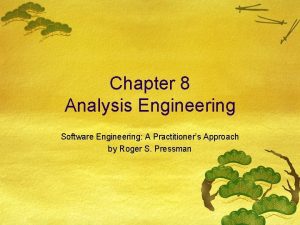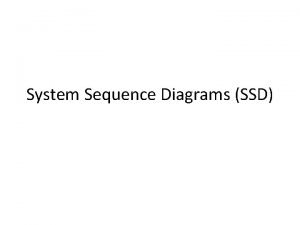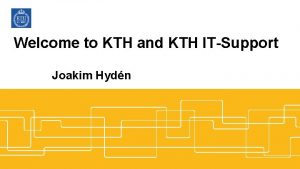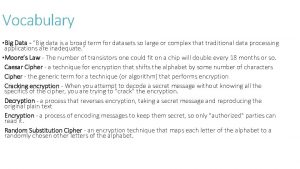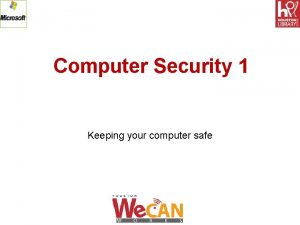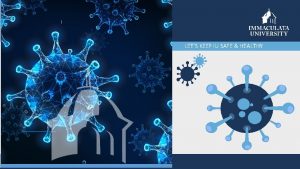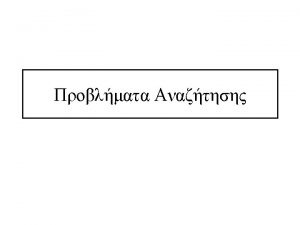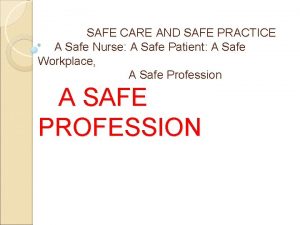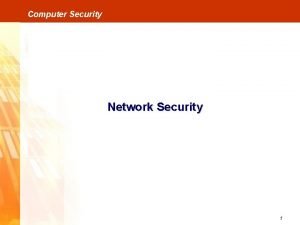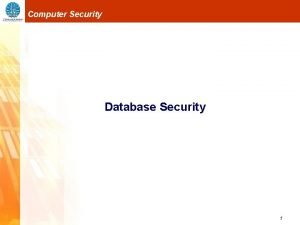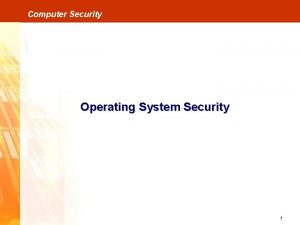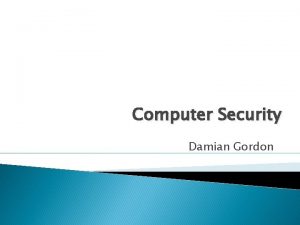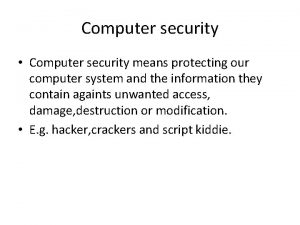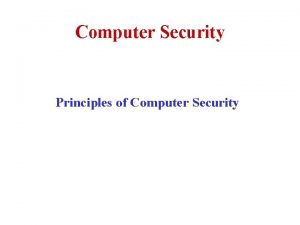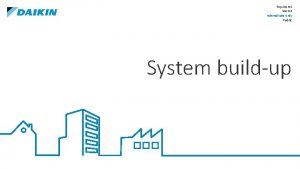Computer Security KEEP IT SECRET KEEP IT SAFE





























- Slides: 29

(Computer) Security “KEEP IT SECRET, KEEP IT SAFE”

Chatham House Rule When a meeting, or part thereof, is held under the Chatham House Rule, participants are free to use the information received, but neither the identity nor the affiliation of the speaker(s), nor that of any other participant, may be revealed.

Why Are We Talking About Computer Security in Discrete Mathematics? Falls under the heading of “Why do I care? ” Many of the techniques used in Computer Security involve encryption Best encryption techniques use discrete math ◦ To make it secret ◦ To break the secrecy ◦ It’s a lot of fun!

Intrusion Detection Physical intrusions Cyber intrusions ◦ Cyber security is of no use if the intruder can physically attack the system.

Message and Data Security How can we keep stored information secure? How can we keep messages (data) secure? In reality, these are basically the same question, so we will concentrate on messages because they are more fun to talk about.

The Three Important Goals C Confidentiality: Only the right people can know (includes privacy) I Integrity: The message received is the message sent A Authenticity: The message is from the author, not an imposter Someone has a sense of humor.

Terms Clear text: Messages that can be read by anyone or the text of the message you wish to send ◦ “The quick brown fox jumps over the lazy dog. ” ◦ Also called plain text Secret text: Message that has somehow been scrambled or otherwise hidden ◦ “Gsv jfrxp yildm ulc qfnkh levi gsv ozab wlt. ” ◦ During this presentation, you can assume all messages are sent in some kind of secret text. Alice: The person wishing to send the message (from) Bob: The intended recipient of the message (to) Charles: The bad guy trying to read, or disrupt, the message (crook) Eve: Anyone trying to eavesdrop on the message (nosey neighbor)

Terms (continued) Code: A pre-agreed upon secret meaning for a message. ◦ Cannot be broken if used correctly ◦ Code book must be secret and safe ◦ Only pre-agreed messages can be sent Cypher or encryption: A mathematical method to change the clear text to secret text ◦ Method must be agreed upon in advance ◦ Most rely upon a key that must be secret and safe ◦ Any message can be sent ◦ Any encryption can be broken by a “brute force attack”…may take forever PET PEEVE: Codes (encoding) and cyphers (encryption) are not the same, but we won’t be picky as no one else really cares about the difference.

Confidentiality A message from Alice to Bob cannot be understood by Charles or Eve, even though it goes via public channels (phone, email, texting, internet, radio …. . )

Examples of Codes and Cyphers Code: ◦ ◦ Clear text: Secret text: Rob the bank Uncle Fred drove Aunt Sally to the mall today. Get out of town…. NOW. The vet says your cat is in great health and not fat at all. Encryption or cypher: ◦ Clear text: The quick brown fox jumps over the lazy dog. ◦ Secret text: Gsv jfrxp yildm ulc qfnkh levi gsv ozab wlt. Because codes can’t be broken and are somewhat limited, we will concentrate on encryption. Besides, computers are very good at encryption.

Background Simple substitution ◦ Each character is replaced by another character using a table known to Alice and Bob, but no one else ◦ ABCDEFGHIJKLMNOPQURSTUVWXYZ ◦ ZYXWVUTSRUQPONMLKJIHGFEDCBA The table must be kept secret or the whole thing doesn’t work. Easy to break (we’ll do one later) Caesar's Cypher is a simpler to remember variation of a simple substitution cypher and is therefore easier to break. ◦ Assign a number to each letter: A=1, B=2 ◦ Add a number to the letter value to get a new letter ◦ Subtract the number from the encrypted letter to get the clear text

Breaking a Simple Substitution Cypher Brute force attack: Try every combination until you hit the right one. ◦ Number of tries is on the order of 26! … too large to be useful ◦ Knowledge of the language (e. g. , English or Klingon) gives the code breaker an edge ◦ The best attack is…. . ◦ ETAOINSHRDLCUMWFGYPBVKJXQZ

What Makes a Good Encryption? • Must be reliable and tolerate errors. Fortunately, humans are good at understanding text messages with minor (and often serious) errors. • Must be impossible, or at least difficult, to decrypt without the key(s) • For streaming data, such as voice or video, must be fast • Should be a public method with privately held keys. (Why? So more people will try to break it. ) • PARANOIA! Should not have ever been touched by the NSA (National Security Agency). • • • Legally mandated encryption with keys held in a “vault” maintained by NSA. DEFEATED. Clipper chip…hardware encryption from NSA (with a back door). DEFEATED. Skipjack phone…on the fly encryption of voice (with an NSA back door). DEFEATED.

Some Industry Standard Encryptions DES Data Encryption Standard ◦ Developed with the help of the NSA ◦ May have a “back door” Oops! ◦ withdrawn by National Institute of Standards and Technology – NIST AES Advanced Encryption Standard ◦ withdrawn by National Institute of Standards and Technology – NIST RSA Ron Rivest, Adi Shamir and Leonard Adleman ◦ First widely used “public key/private key” security ◦ Depends upon factoring large numbers ◦ So far, so good (more later if there is time…. . )

Symmetric Key vs Public/Private key Symmetric key cryptography ◦ ◦ ◦ Same key to encrypt/decrypt Can always be defeated by a “brute force” attack The longer the key, the better the security Periodically changing the key improves the security Key exchange must be private Public key/Private key cryptography ◦ ◦ ◦ One key is held secret, the other is published (literally!) Can always be defeated by a “brute force” attack The longer the key, the better the security Periodically changing the key improves the security Has more uses than Confidentiality

Some Math to Scramble a Message Simple substitution works for up to about 12 year olds Keyed substitution (5736362121) ◦ Works well if only humans are involved ◦ Computers can break this fairly easily Other “symmetric” methods ◦ ◦ Same key to encrypt as decrypt Must keep key safe Can be broken fairly easily Change keys often (must have secret distribution)

One-way Formulas We need something that is one-way ◦ Secret text does not help to find the key ◦ Should tolerate errors ◦ Usually not as good and the inventor thinks it is…. (*sigh*) Best so far involve: ◦ ◦ ◦ One-way encryption Data rotation (? ? ? ) Modular arithmetic (x mod y) Large primes (? ? ? ) Multiple steps

RSA : Rivest, Shamir, and Adleman RSA is the industry standard ◦ ◦ ◦ Key is the problem of factoring large numbers that are semiprime (the product of two primes) Public key / private key asymmetric encryption Uses multiple steps (more at the end of the course if there is time) Uses data rotation Great stuff …. Except …. ◦ Rivest worked for the NSA at one point

Integrity Over public media, is someone changing your messages and stealing data?

Integrity Changed messages ◦ ◦ ◦ Is the message received by Bob the message Alice sent? Enemy action Public key/Private key encryption can be used to “sign” a message. Cannot be forged. Security Certificates are another way to sign a message. Cannot be forged. (? ? ? ) Has the message been scrambled? Enemy action. Has the message been scrambled? Errors.

Authenticity Over public media, who are you really talking to?

Authenticity Who really sent those messages ◦ Is someone else posing as Alice? Enemy action ◦ Public key/Private key encryption can be used to “sign” a message. Cannot be forged. ◦ Security Certificates are another way to sign a message. Cannot be forged. (? ? ? ) ◦ What if I hack the certificate authority? ◦ What if I hack the method used (public key/ private key) to sign the certificate? Did these updates really come from Microsoft?

So, why do I care? Privacy ◦ It is harder to read encrypted files ◦ It is harder to read encrypted directories ◦ Do you really want someone reading your purchase information? Anyone want to go to Target? Battlefield communications ◦ What is the enemy trying to do? ◦ Keeping the enemy from knowing what you are doing ◦ Weapon systems depend upon electronics so the electronics must be protected ◦ In Iraq, drone video was being watched by terrorists in Iraq at the same time it was being viewed by remote pilots ◦ Heddy Lamar invented frequency hopping to foil Germans jamming torpedoes. ◦ IEEE honored her for the invention ◦ You would not have a cellphone without her

So, why do I care? (continued) Industrial spying Control the sources of information and you can control your people. ◦ Great Firewall of China ◦ Alan Moore — “People shouldn't be afraid of their government. Governments should be afraid of their people. ” (anyone recognize this? ) Cyber-Physical Systems (CPS) ◦ The electrical power grid is controlled by electronics ◦ The chances are that the brakes in your car are connected to a sensor that “asks” the car’s computer to apply the brakes. More and more cars are wirelessly connected to something outside the car. ◦ CPS can be observed and therefore leak information to attackers ◦ CPS cannot be easily hidden

Oops? Any security can be broken. Period. Brute force attacks ◦ Try every possible key ◦ Use many, many computers to try many keys at once ◦ With luck, by the time the key is broken the data is too stale to be of use. Do you really care if someone cracks your Master. Card account 25, 000 years from now? ◦ Good keys may take longer to find by brute force than the life of the universe ◦ Oops, what if the key is guessed on the 10 th guess? Statistical attacks ◦ Analyze intercepted messages for patterns. ◦ Any knowledge of the possible content of the message helps

Oops? (continued) Social engineering attacks ◦ The adversary might be a con artist ◦ Many, many users will give you their login information if you are “Jack from IT. ” ◦ The three most common places keep their login information are post-its on the monitor, under the keyboard, and in the desk drawer closest to the keyboard. ARGH! Physical attacks ◦ If I can get to your Cisco router, I can drop your network for hours, maybe days, in less than a minute. ◦ What good is the encryption on your hard drive after I smash it? ◦ Many companies in the World Trade Center used the same organization for disaster recovery. This organization had its offices and backups in the World Trade Center.

Things to Think About at 3: 00 a. m. Any security can be broken. Security experts “know” their security cannot be broken. For example, the inventor of PGP offered a reward to anyone who could break into his email in less than the life of the universe. It took less than six months for someone to collect the prize. The newer version is better. More and more of our lives are on line. The US press was accidentally tipped off as to the start of the first Iraq war before it happened. The information was leaked when a pizza delivery van arrived at the Pentagon at 2: 00 a. m. The good guys work eight hour days. The bad guys work 24 seven Governments and organized crime are into hacking your security Any security can be broken.

In closing…. para·noia noun ˌper-ə-ˈno i-ə, ˌpa-rə- medical : a serious mental illness that causes you to falsely believe that other people are trying to harm you : an unreasonable feeling that people are trying to harm you, do not like you, etc. Bishop, Matt. Introduction to computer security. Addison-Wesley Professional, 2004. Stallings, William. Network and internetwork security: principles and practice. Vol. 1. Upper Saddle River, NJ: Prentice Hall, 1995. Howser, Gerry, and Bruce Mc. Millin. "Modeling and reasoning about the security of drive-by-wire automobile systems. " International Journal of Critical Infrastructure Protection 5. 3 (2012): 127 -134. Samanthula, Bharath K. , et al. "A secure data sharing and query processing framework via federation of cloud computing. " Information Systems (2013). Eighth Annual IFIP WG 11. 10 International Conference on Critical Infrastructure Protection (Chatham House rules of non -disclosure)

Questions?
 Keep it secret keep it safe
Keep it secret keep it safe Ethos examples
Ethos examples Security design principles examples
Security design principles examples Private securit
Private securit Safe feed safe food
Safe feed safe food Safe people safe places
Safe people safe places Stakeholder mapping exercise
Stakeholder mapping exercise Stakeholders mapping
Stakeholders mapping Use case diagram for safehome security system
Use case diagram for safehome security system Use case diagram for safehome security system
Use case diagram for safehome security system On an ssd, a dashed arrow usually represents what?
On an ssd, a dashed arrow usually represents what? Osi security architecture model with neat diagram
Osi security architecture model with neat diagram Guide to network security
Guide to network security Wireless security in cryptography
Wireless security in cryptography Visa international security model in information security
Visa international security model in information security Electronic mail security in network security
Electronic mail security in network security Cnss model 27 cells example
Cnss model 27 cells example E commerce security meaning
E commerce security meaning Seven touchpoints for software security
Seven touchpoints for software security Security guide to network security fundamentals
Security guide to network security fundamentals Security guide to network security fundamentals
Security guide to network security fundamentals Kth eduroam
Kth eduroam Big data vocabulary
Big data vocabulary Listerine trade secret case
Listerine trade secret case The secrets to successful strategy execution
The secrets to successful strategy execution The secret lives of sgt john wilson
The secret lives of sgt john wilson Walter mitty quotes
Walter mitty quotes Secret garden setting
Secret garden setting Tituba the crucible
Tituba the crucible Secret class129
Secret class129
